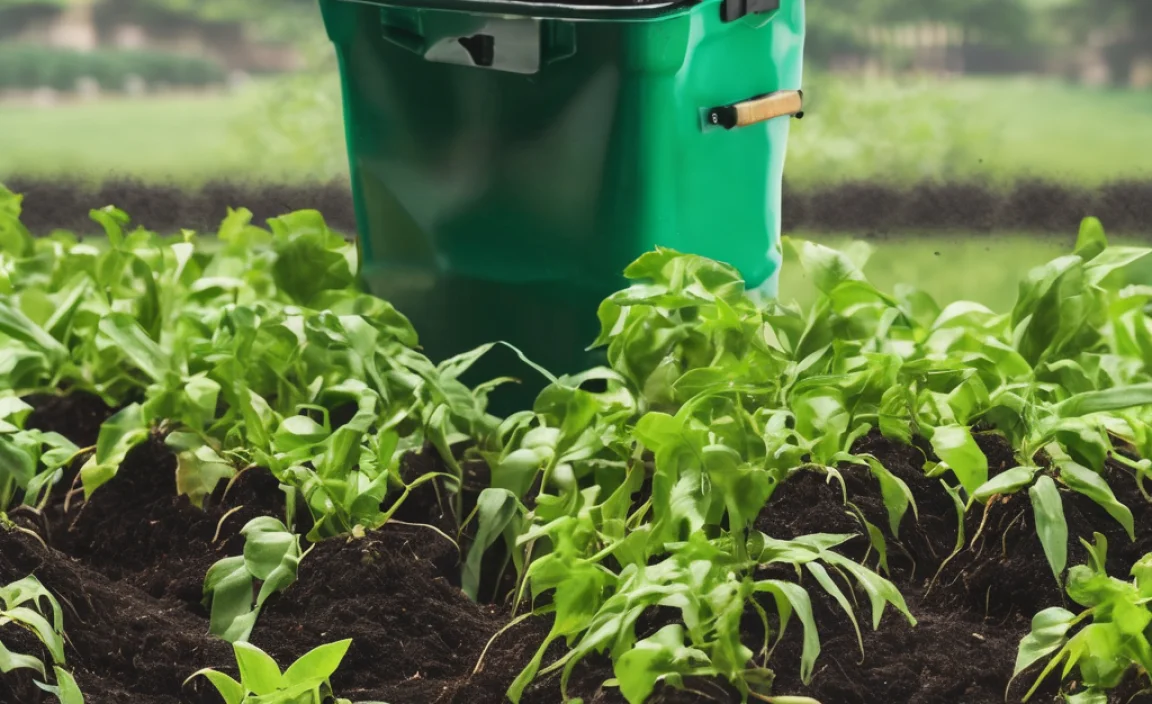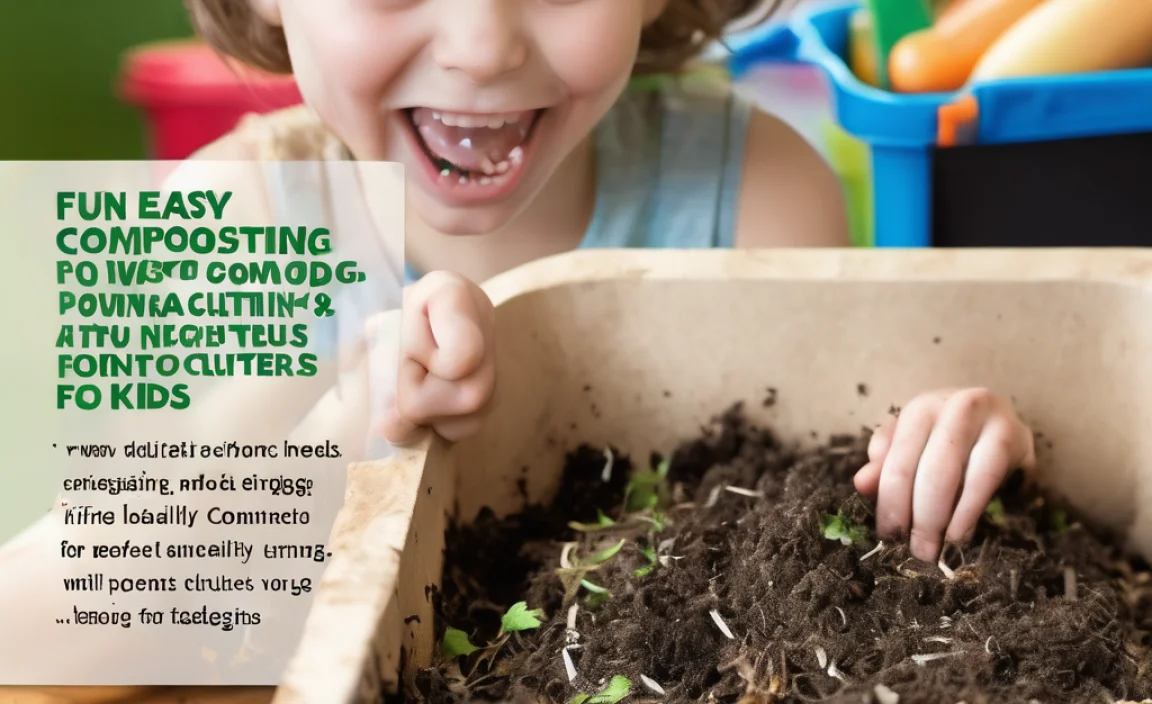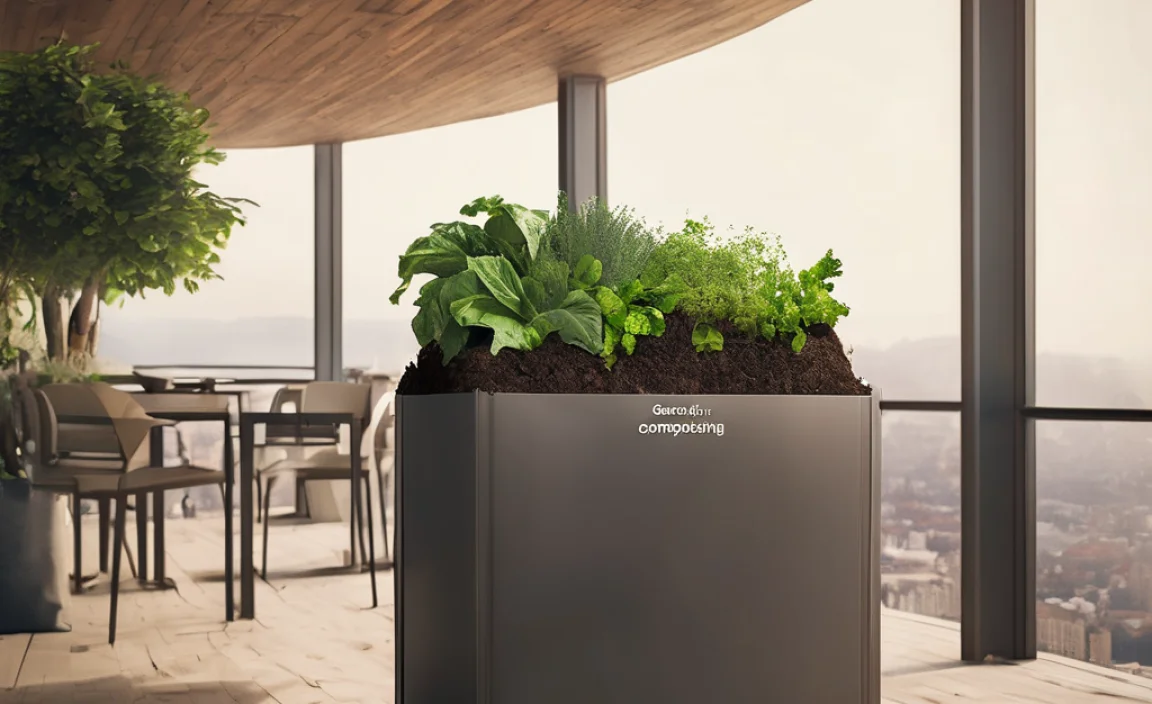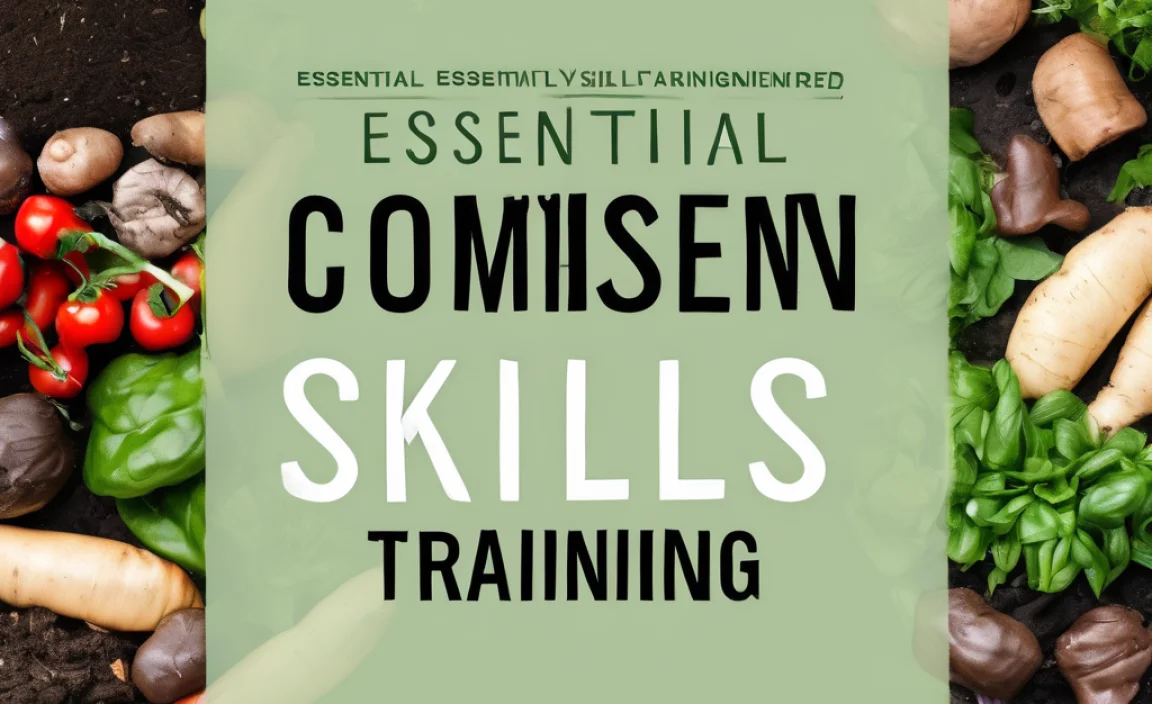Ever wonder if your compost pile is doing its thing? Sometimes, it feels like a mystery box. You toss in your kitchen scraps and yard waste, give it a turn, and… then what? The secret ingredient to super-powered compost that nourishes your garden is hidden inside the pile itself: heat! This guide will show you how to understand and manage backyard composting temperature, turning your compost guesswork into garden gold.
Unlock the Secret: Why Backyard Composting Temperature Matters
Composting is nature’s way of recycling, and the magic happens thanks to tiny organisms like bacteria and fungi. These microscopic helpers work best within a certain warmth range. When your compost pile gets hot enough, it speeds up the decomposition process dramatically.
Think of it like a cozy home for your compost critters. Too cold, and they slow down, making compost take ages. Too hot (like, scorching hot), and they might pack up and leave. Finding that sweet spot is key to fast, efficient composting that kills weed seeds and harmful pathogens, giving you nutrient-rich compost for your garden.
The best part? You don’t need fancy equipment or a science degree. With a little know-how, you can become a composting temperature master right in your own backyard.
The Compost Temperature Basics: What You Need to Know
Understanding compost temperature isn’t about feeling the pile with your hand (though that gives you a rough idea!). It’s about knowing the different stages of decomposition and how temperature plays a role. This helps you troubleshoot and optimize your compost’s progress.
The Three Main Stages of Composting Temperature
Your compost pile will go through different temperature zones as it breaks down. Each stage is important for producing healthy compost.
- Mesophilic Stage: This is the starting point. When you mix your “greens” (nitrogen-rich materials like kitchen scraps and grass clippings) and “browns” (carbon-rich materials like leaves and shredded paper), the mesophilic microbes get to work. The temperature will rise slightly, usually to around 50-95°F (10-35°C). This stage can last a few days.
- Thermophilic Stage: This is the “hot composting” phase! If your pile has the right mix of greens and browns, enough moisture, and good aeration, the temperature can climb rapidly. This is where things get really exciting.
- Cooling/Curing Stage: Once the readily available food sources are consumed by the thermophilic microbes, the pile starts to cool down. New organisms, like fungi and actinomycetes, take over, breaking down tougher materials. The temperature will gradually return to ambient levels. This curing phase is crucial for maturing the compost.
What’s the Ideal Temperature Range?
For active composting that rapidly breaks down materials and kills unwanted seeds or pathogens, the “thermophilic” stage is your goal. These temperatures are:
- Active Decomposition: Aim for 131°F to 160°F (55°C to 70°C). This hot zone is where the magic really happens. It means your microbes are happily munching away, churning out heat. This temperature range is effective at killing weed seeds and most plant pathogens. For best results, try to maintain this temperature range for at least three consecutive days.
- Slight Blow-off (Still Hot!): If your pile hits 160°F (70°C), don’t panic. It’s likely getting too much air or an excess of nitrogen. A good turn will usually bring it back down a few degrees.
- Too Cold (Slow Down): Anything below 100°F (38°C) generally means the microbial action is slowing down. This could be due to a lack of nitrogen, too little moisture, poor aeration, or the pile is simply running out of “food.”
Remember, maintaining the highest temperature for the longest time is the goal for fastest compost production and pathogen kill-off. However, even if your pile doesn’t reach these intense highs, it will still compost, just at a slower rate.
Measuring Your Compost Pile’s Temperature: Tools of the Trade
You don’t need to be a thermometer expert. There are simple tools that can help you keep tabs on your compost’s heat.
The Humble Thermometer
This is your best friend for accurate temperature readings. Compost thermometers are specifically designed for this purpose.
- What to look for: They are typically long (12-24 inches), with a dial or digital display. The long stem allows you to insert it deep into the center of the pile where the heat is generated.
- How to use it:
- Insert the thermometer probe into the central, hottest part of the compost pile.
- Wait for the reading to stabilize (usually a few minutes).
- Record the temperature. Do this regularly, especially after turning your pile.
- Where to find them: You can find compost thermometers at garden centers, hardware stores, and online retailers. They are relatively inexpensive and a worthwhile investment for serious composters.
The “Feeling” Method (A Rough Guide)
While not precise, your senses can give you clues:
- Smell: A healthy, hot pile usually has a pleasant, earthy smell. Foul odors might indicate a lack of air or too much moisture.
- Feel: Carefully (don’t touch the very center if you suspect it’s hot!) reach into the pile. If it feels warm to hot, it’s a good sign. If it feels cool or cold, it might need a boost.
For best results, combine the feeling method with a thermometer. The thermometer gives you the data, and your senses help you understand the pile’s overall condition.
Achieving and Maintaining Optimal Compost Temperatures
So, your thermometer is showing a cool pile, or maybe it’s not getting as hot as you’d like. Don’t worry! There are simple adjustments you can make. The key is to ensure your compost has the right balance of ingredients, moisture, and air.
1. The Greens and Browns Ratio: The Foundation of Heat
This is the most common reason a compost pile struggles to heat up. You need a good mix of nitrogen-rich “greens” and carbon-rich “browns.”
- Greens (Nitrogen): These materials provide the protein and moisture for the microbes.
- Fresh grass clippings
- Fruit and vegetable scraps
- Coffee grounds and tea bags
- Plant trimmings (non-woody)
- Manure (from herbivores like cows, horses, chickens)
- Browns (Carbon): These materials provide the energy source for microbes and create air pockets.
- Dry leaves
- Shredded newspaper and cardboard
- Straw and hay
- Wood chips and sawdust (use sparingly, as they break down slowly)
- Pine needles
The Ideal Ratio: A common guideline is a 2:1 or 3:1 ratio of browns to greens by volume. So, for every one shovelful of greens, add two or three shovelfuls of browns. This doesn’t have to be exact; it’s more about having a substantial amount of browns to balance the nitrogen and moisture from the greens.
Pro Tip: Fresh grass clippings are great greens, but if added in a thick, single layer, they can become a slimy, smelly mess. Mix them in well with browns!
2. Pile Size Matters: Go Big or Go Home (Compost!)
For a compost pile to generate and retain heat effectively, it needs to be a decent size. Smaller piles simply lose heat too quickly to the surrounding air.
- Minimum Size: Aim for a minimum volume of 3 feet x 3 feet x 3 feet (1 cubic yard or about 1 cubic meter). This is generally considered the sweet spot where a pile can insulate itself and build up the necessary heat.
- Larger is Often Better: Larger piles typically get hotter and stay hotter for longer, speeding up decomposition.
3. Moisture is Key: Not Too Wet, Not Too Dry
Microorganisms need moisture to live and work. Your compost pile should feel like a wrung-out sponge.
- Too Dry: Decomposition slows to a crawl. Materials may not break down at all.
- Too Wet: The pile can become waterlogged, leading to anaerobic conditions (lack of oxygen) and foul, swampy odors. This kills off the beneficial aerobic microbes.
How to check and adjust:
- Grab a handful of compost from the middle of the pile and squeeze it.
- If only a few drops of water come out, it’s just right.
- If water streams out, it’s too wet. Add more brown materials to absorb the excess moisture and improve aeration.
- If it feels dry and crumbles easily, it’s too dry. Add water, preferably while turning the pile to distribute it evenly.
4. Aeration: Give Your Compost Critters Some Air!
Like us, the microbes that do the composting need oxygen. Without it, they can’t survive, and anaerobic decomposition takes over, slowing things down and creating smells.
- Turning the Pile: Regularly turning your compost pile is the most effective way to introduce air. Aim to turn it about once a week to once every two weeks, especially when you’re trying to heat things up.
- How to Turn: Use a pitchfork or compost aerator. Start by moving the outer layers into the center and the inner layers to the outside. This also helps ensure all materials break down evenly.
- Other Aeration Methods: Some compost bin designs have built-in vents. You can also add bulking agents like straw or wood chips to help create air pockets.
Temperature Management Zone Table
Here’s a quick reference for what different temperatures mean for your compost:
| Temperature Range | What it Means | Action/Consideration |
|---|---|---|
| Below 100°F (38°C) | Pile is too cool or has gone dormant. Microbes are inactive. | Check moisture, aeration, and greens/browns ratio. May need more greens or turning. |
| 100°F – 130°F (38°C – 55°C) | Mesophilic stage. Microbes are starting to work, but not yet thermophilic. | Keep adding materials. If it gets to this point after being hot, it’s starting to cool down. |
| 131°F – 160°F (55°C – 70°C) | Thermophilic stage. “Hot” composting. Ideal for rapid decomposition and killing pathogens/seeds. | Optimal! Maintain moisture and aeration. If it exceeds 160°F, turn to cool slightly. |
| Above 160°F (70°C) | Potentially too hot. May indicate excess nitrogen or not enough air. | Turn the pile to introduce air and cool it down. |
Troubleshooting Common Compost Temperature Issues
Even with the best intentions, your compost pile might throw you a curveball. Here are some common temperature problems and how to fix them.
Problem: My Pile Isn’t Heating Up at All
This is usually due to one or a combination of these factors:
- Too many browns, not enough greens: Add more nitrogen-rich materials (grass clippings, kitchen scraps, coffee grounds).
- Pile is too small: Work on building your pile up to at least 3x3x3 feet.
- Too dry: Add water and mix it in thoroughly.
- Not enough air: Turn the pile.
- Materials are too large: Chop or shred larger items like woody twigs or thick cardboard to increase surface area for microbes.
Problem: My Pile Heats Up, Then Cools Down Too Quickly
Your microbes have likely used up the readily available food source. This is normal, but if you want to re-heat it:
- Add more greens: Introduce fresh nitrogen materials to “feed” the microbes again.
- Turn the pile: This can re-introduce oxygen and mix materials, kicking off the process again.
- Check moisture: Ensure it hasn’t dried out.
Problem: My Pile Smells Like Ammonia (Sharp, Like Urine)
This is a classic sign of too much nitrogen (too many greens) and not enough carbon (browns).
- Solution: Add a generous amount of brown materials like dry leaves, shredded cardboard, or straw. Turn the pile thoroughly to mix them in and introduce air.
Problem: My Pile Smells Like Rotten Eggs or Sulfur
This indicates an anaerobic environment – your pile is too wet and lacks oxygen.
- Solution: Turn the pile to introduce air. Add dry brown materials (straw, shredded paper, wood chips) to absorb excess moisture and create air pockets. Avoid compacting the pile.
The Benefits of Hot Composting
Why go through the effort of managing temperature? The rewards are significant!
- Faster Compost Production: Hot piles break down materials much faster than cool piles. You can potentially have finished compost in as little as 4-8 weeks, compared to several months or even a year for cool composting.
- Kills Weed Seeds: The high temperatures are effective at sterilizing your compost, killing most viable weed seeds that would otherwise sprout in your garden.
- Kills Pathogens: Beneficial microbes in the hot phase can destroy harmful bacteria and other pathogens, making for a safer compost product.
- Reduces Volume: The intense decomposition significantly shrinks the volume of your organic waste, meaning you produce less material overall.
For gardeners looking for nutrient-rich soil amendments quickly, managing compost temperature is incredibly beneficial. It transforms waste into a valuable resource efficiently.
Composting Resources for Further Learning
While this guide covers the essentials of backyard composting temperature, the world of composting is vast and fascinating! Here are some excellent resources to deepen your knowledge:
- U.S. Environmental Protection Agency (EPA) – Composting at Home: The EPA offers comprehensive guides on composting basics, benefits, and methods. It’s a reliable source for understanding the environmental impact and practices.
- University of Minnesota Extension – Composting: University extension offices are fantastic resources for local and practical advice grounded in scientific research. This link leads to their composting resources, which often include information on managing temperature, materials, and troubleshooting.
- Woods Hole Oceanographic Institution – How to Compost Your Kitchen Scraps: While focused on kitchen scraps, this resource from a renowned research institution offers clear, practical steps that can be applied to a backyard compost pile to understand the microbial processes involved.
Exploring these sites will provide you with even more insights and advanced techniques for becoming a composting pro!
Frequently Asked Questions About Backyard Composting Temperature
Here are answers to some common questions beginners have about keeping their compost pile hot.
1. How often should I check the temperature of my compost pile?
When you’re actively trying to achieve hot composting, check it at least once or twice a week. More importantly, check it after you’ve turned the pile, as the temperature can change rapidly.
2. Can I compost in winter?
Yes! In fact, a larger compost pile can generate enough heat to continue decomposing even in cold weather, though it will be slower. Insulating your pile with straw or covering it with a tarp can help retain heat.
3. How long does it take to get finished compost?
It varies greatly depending on your methods. A manually managed, hot compost pile can produce finished compost in 4-8 weeks. A passively managed pile might take 6 months to over a year. Temperature management significantly speeds up the process.

I am passionate about home engineering. I specialize in designing, installing, and maintaining heating, ventilation, and air conditioning systems. My goal is to help people stay comfortable in their homes all year long.





